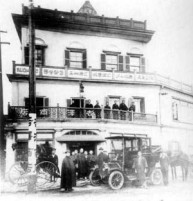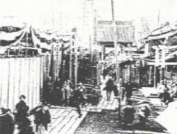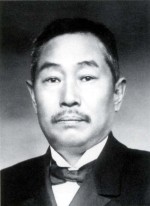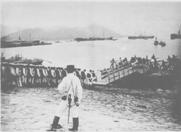1900
March
The first Japanese made film projectors are sold by Yoshizawa Shoten (company), which is considered the oldest film company in Japan. In September 1896,Yoshizawa Shoho (shop), an exporter of mainly woodblock prints merged with Marukawa Shoten, which imported, produced and sold magic lanterns, to create Yoshizawa Shoten. Irie Yoshiro writes that Kawaura Kenichi (1868-1957), first Yoshizawa Shoho's manager since perhaps 1895 and later Yoshizawa Shoten's owner, "pioneered the business model of the twentieth century film industry by establishing a circuit that started with import or production and completed in exhibition (Irie Yoshiro, p.126)". In other words, vertical integration, the control of production, distribution and exhibition of a film.
In February 1897, Yoshizawa obtained a Lumiere's Cinematographe from an Italian resident in Japan called Giovanni Braccialini (Peter B. High names him Cipione Braccialini, p. 28) and organized the first exhibition of films in the city of Yokohoma at the Minato-za theater on 9 March 1897. Years later Yoshizawa produced what has been regarded as the first Japanese film documentary, HOKUSHIN JIHEN KATSUDO DAISHASHIN (Grand Motion Picture on the Boxer Rebellion), which opened at Tokyo's Kinki-kan theatre on 18 October 1900. In 1903, Yoshizawa converted a theatre in Asakusa, Tokyo, into the first permanent cinema in the country, the Denkikan. The company also built Japan's first film studio in Meguro, Tokyo, in 1908. Soon the studio began to produce films at such speed that the first screenwriting department in Japanese film history was created to meet the growing demand for stories. In 1909 there was also a failed attempt to establish an acting school at the studio. Furthermore, in June that year Yoshizawa helped publishing the oldest surviving film magazine, Katsudo Shashin Kai (The Cinematograph).
Sources:
Irie Yoshiro, Yoshizawa Shoten-sha - Kawaura Kenichi no Sokuseki (1) Yoshizawa Shoten no Tanjo / Trajectories of Kawaura Kenichi, the Owner of Yoshizawa & Co.(1)Origins of the Oldest Film Company , Tokyo Kokuritsu Kindai Bijutsukan Kenkyu Kiyo / Bulletin of the National Museum of Modern Art, Tokyo, (18), 2014, main article 32-63, and 126 (Translated by Kinoshita Chika).
Yohohama Kaiko Shiryokan / Yokohama Archives of History, Yokohama ni Eigankan Nakkata Koro.
Peter B. High, The Dawn of Cinema in Japan, Journal of Contemporary History, Vol. 19, 1984, p. 28.
Joanne Bernardi, Writing in Light: The Silent Scenario and the Japanese Pure Film Movement, Detroit: Wayne State University Press, 2001, pp.67-68 and 129.
Komatsu Hiroshi, Some Characteristics of Japanese Cinema before World War I, in Reframing Japanese Cinema, Ed. Arthur Nolletti and David Desser, Indiana UP, 1992, pp. 236-7.




